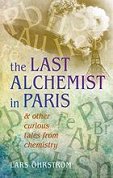Henning Hopf, Technische Universität Braunschweig, Germany, reviews the book The Last Alchemist in Paris & Other Curious Tales from Chemistry by Lars Öhrström, Chalmers University of Technology, Gothenburg, Sweden.
Known Concept Differently
Never before have there been so many popular books on chemistry than today. And very often they use (exciting) stories about the chemical elements or important everyday “compounds” and pharmaceuticals (the term “chemical” is usually avoided) to explain chemical concepts or relationships to the reader. This storytelling approach is the bait to make the “hard” chemical facts more palpable to the reader. Öhrström´s book relies on the same approach and is thus more an extension of the genre rather than a new way to bring chemistry to the lay reader.
Yet, the book differs in more than one aspect from previous texts in this area.
First of all there is the vivid and colorful—yes, catchy—style of the author, a born storyteller.
Secondly, there is the selection of the stories told. As the ordering principle Öhrström uses the Period Table of the Elements, just as Primo Levi did in his masterpiece. He selects roughly two dozen elements from the Periodic Table, elements that later lead to the 22 chapters of the book. Among the chosen elements is helium, for whose ”story“ the Hindenburg explosion at Lakehurst is selected, the detailed circumstances of which are still debated today. Another element is hydrogen/deuterium, where the story centers around heavy water as employed by the German “Uranprojekt” and the courageous and exciting actions taken by commandos against the electrolysis plant in Rjukan, Norway. The title-giving alchemist is August Strindberg, whose alchemistic experiments in the Hotel Orfila in Paris were directed at the century-old mystery of making gold. During those years, Strindberg was suffering from a severe psychosis, possibly of a manic-depressive nature. This gives the author the opportunity to describe the lithium therapy used to treat bipolar disorders.
General Knowledge Combined with Science
In all these (and the other) cases, the reader already possesses some previous, often nonchemical knowledge, which was usually acquired through the media (film, television, popular magazines, or books). And this knowledge is used by the author to draw the reader into the “real” world of chemistry and occasionally physics; thus, the reader learns in a solid and reliable way about redox reactions, the notion of isotopes, and the gas laws, to cite more or less arbitrarily some of the many concepts treated in the book.
Furthermore, it is attractive that many of the examples (viz. stories) used to illustrate the scientific facts and ideas have a decidedly Scandinavian background (the author is an active scientist at Chalmers University in Gothenburg)—not everything has been described and discovered by “American scientists”.
Altogether the author succeeds admirably in showing that chemistry is an essential part of our lives. Often this importance is not seen at first sight; to reveal the chemical “core” of many of the stories told here is the main purpose of this highly recommendable book.
Conclusion
It is often said in public discussions that the sciences, and chemistry in particular, have a duty to explain to the general public in understandable terms and simple language what science is all about. In my opinion science has fulfilled this obligation over and over again. It is now the duty of the general public to take note of books such as this one, rather than escape into dream worlds of poison, toxicity, and environmental disaster when the word ”chemistry“ is mentioned.

- The Last Alchemist in Paris & Other Curious Tales from Chemistry,
Lars Öhrström,
Oxford University Press, Oxford, UK, 2013,
257pp, EUR 21.91; $ 31.46.
ISBN 978-0-19-966109-1




